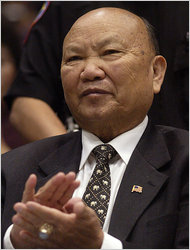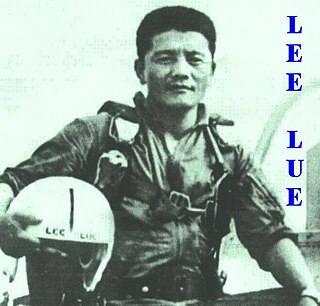| |||||
| Decades: | |||||
|---|---|---|---|---|---|
| See also: | Other events of 2007 List of years in Laos | ||||
The following lists events that happened during 2007 in Laos .
| |||||
| Decades: | |||||
|---|---|---|---|---|---|
| See also: | Other events of 2007 List of years in Laos | ||||
The following lists events that happened during 2007 in Laos .

The Hmong people are an indigenous group in East Asia and Southeast Asia. In China, the Hmong people are classified as a sub-group of the Miao people. The modern Hmong reside mainly in Southwestern China and Mainland Southeast Asian countries such as Vietnam, Laos, Thailand, and Myanmar. There are also diaspora communities in the United States, Australia, and South America.

Vang Pao was a major general in the Royal Lao Army and later a leader of the Hmong American community in the United States.

The Laotian Civil War was waged between the Communist Pathet Lao and the Royal Lao Government from 23 May 1959 to 2 December 1975. The Kingdom of Laos was a covert theater during the Vietnam War with both sides receiving heavy external support in a proxy war between the global Cold War superpowers. The fighting also involved the North Vietnamese, South Vietnamese, American and Thai armies, both directly and through irregular proxies. The war is known as the Secret War among the American CIA Special Activities Center, and Hmong and Mien veterans of the conflict.
Wat Tham Krabok is a Buddhist temple (wat) in the Phra Phutthabat District of Saraburi Province, Thailand.

Hmong Americans are Americans of Hmong ancestry. Many Hmong Americans immigrated to the United States as refugees in the late 1970s, with a second wave in the 1980s and 1990s. Over half of the Hmong population from Laos left the country, or attempted to leave, in 1975, at the culmination of the Laotian Civil War.
The insurgency in Laos is a low-intensity conflict between the Laotian government on one side and former members of the Secret Army, Laotian royalists, and rebels from the Hmong and lowland Lao ethnic minorities on the other. These groups have faced reprisals from the Lao People's Army and Vietnam People's Army for their support of the United States-led, anti-communist military campaigns in Laos during the Laotian Civil War, which the insurgency is an extension of itself. The North Vietnamese invaded Laos in 1958 and supported the communist Pathet Lao. The Vietnamese communists continued to support the Pathet Lao after the end of the Laotian Civil War and the establishment of the Lao People's Democratic Republic. At least 100,000 Hmong civilians were killed as the result of Laotian governmental policies, in what has sometimes been referred to as the Hmong genocide.

Major Lee Lue was a Laotian Hmong fighter bomber pilot notable for flying 10-12 combat missions Kingdom of Laos. Lee Lue flew continuously, as many as 10 missions a day and averaging 112 combat missions a month to build a total 10-12 sorties. Lee Lue was the leader of the special group of Hmong pilots flying T-28Ds from Long Tieng against the Pathet Lao and North Vietnamese positions. The group was funded by the CIA and was part of the regular Royal Lao Air Force, but took orders directly from MR2 Commander Gen. Vang Pao. His T-28 was shot down by anti-aircraft fire over Muang Soui, crashing in a mountainous area near Ban Phou Pheung Noi on July 12, 1969. At the time of his death, he had 800 combat missions total the 14 months o

The Hmong and Lao Memorial, or Lao Veterans of America Monument, is a granite monument, bronze plaque and living memorial in Arlington National Cemetery in the US. Dedicated in May 1997, it is located in Section 2 on Grant Avenue between the path to the JFK memorial and the Tomb of the Unknowns, in Arlington National Cemetery, Arlington, Virginia, in the United States. The Laos–Hmong memorial commemorates the veterans of the "Secret War" in Laos who fought against invading Soviet Union-backed North Vietnam Army forces of the People's Army of Vietnam and communist Pathet Lao guerrillas. Approved by the U.S. Department of Defense, Arlington National Cemetery, and the U.S. Department of the Army, but designed and paid for privately by the Lao Veterans of America, Inc., the Lao Veterans of America Institute, and The Centre for Public Policy Analysis, the memorial stands as a tribute to the Hmong, Lao, other ethnic groups, and American clandestine and military advisers who made up the Secret War effort during the Vietnam War. The Lao Veterans of America, Inc. is the nation's largest ethnic Laotian- and Hmong-American veterans organization.

The alleged 2007 Laotian coup d'état plan was a conspiracy allegation by the United States Department of Justice that Lt. Col. Harrison Jack (Ret.) and former Royal Lao Army Major General Vang Pao, among others conspired in June 2007 to obtain large amounts of heavy weapons and ammunition to overthrow the Communist government of Laos in violation of the Neutrality Act. The charges were ultimately dropped and the case helped serve to further highlight, instead, major human rights violations by the Lao government against the Hmong ethnic minority, Laotian refugees, and political dissidents.

Relations between Laos and the United States officially began when the United States opened a legation in Laos in 1950, when Laos was a semi-autonomous state within French Indochina. These relations were maintained after Laos' independence in October 1953.
The Center for Public Policy Analysis (CPPA), or Centre for Public Policy Analysis, was established in Washington, D.C., in 1988 and describes itself as a non-profit, non-partisan, think tank and research organization. The CPPA is a non-governmental organization (NGO) focused on foreign policy, national security, human rights, refugee and international humanitarian issues. Its current executive director is Philip Smith.
Jerrold B. Daniels or Jerry Daniels was a CIA Paramilitary Operations Officer (PMOO) in their Special Activities Center who worked in Laos and Thailand from the early 1960s to the early 1980s. He was known by his self-chosen CIA call-sign of "Hog." In the early 1960s, he was recruited by the CIA as a liaison officer between Hmong General Vang Pao and the CIA. He worked with the Hmong people for the CIA's operation in Laos commonly called the "Secret War" as it was little known at the time. In 1975, as the communist Pathet Lao and North Vietnamese Army advanced on the Hmong base at Long Tieng, Daniels organized the air evacuation of Vang Pao and more than two thousand of his officers, soldiers, and their families to Thailand. Immediately after the departure of Daniels and Vang Pao, thousands more Hmong fled across the Mekong river to Thailand, where they lived in refugee camps. From 1975 to 1982 Daniels worked among Hmong refugees in Thailand facilitating the resettlement of more than 50,000 of them in the United States and other countries.
The Lao Human Rights Council, Inc. (LHRC) is a non-profit, non-partisan, non-governmental (NGO) refugee and human rights organization. It is based nationally, and internationally, with chapters in Colorado, Wisconsin and Minnesota. The Lao Human Rights Council, Inc. researches, and provides information and education regarding the plight of Laotian and Hmong people, and refugees persecuted in Laos, the Socialist Republic of Vietnam and Thailand. It was founded by Dr. Pozbeb Vang, Vang Pobzeb of Greenbay Wisconsin. The Lao Human Rights Council, Inc. is currently headed by Vaughn Vang, an educator, and former political refugee from the Royal Kingdom of Laos, who is a Hmong-American—and who was born, and grew up, in Laos prior to the North Vietnamese invasion of Laos and Marxist takeover in 1975.
Operation Momentum was a guerrilla training program during the Laotian Civil War run by the Central Intelligence Agency to raise a guerrilla force of Hmong hill-tribesmen in northeastern Laos to fight the North Vietnamese Army (PAVN) and their Pathet Lao allies. It was planned by James William Lair and carried out by the Thai Police Aerial Reinforcement Unit. Begun on 17 January 1961, the three-day Auto Defense Choc course graduated a clandestine guerrilla army of 5,000 warriors by 1 May, and of 9,000 by August. It scored its first success the day after the first ADC company graduated, on 21 January 1961, when 20 ADC troopers ambushed and killed 15 Pathet Lao.

Wangyee Vang is a Hmong-American community leader, educator and elder from Fresno, and the Central Valley, of California.
The Lao Veterans of America Institute (LVAI) is a national non-profit organization based in Fresno, and the Central Valley, of California, with chapters throughout California. It is one of the largest ethnic Lao- and Hmong-American veterans organizations representing tens of thousands of Lao Hmong veterans who served in the Vietnam War in the Royal Kingdom of Laos as well as their refugee families who were resettled in the United States after the conflict.
Operation Pigfat was a crucial guerrilla offensive of the Laotian Civil War; it lasted from 26 November 1968 to 7 January 1969. Launched by Hmong tribal soldiers backed by the Central Intelligence Agency, it was based on the usage of overwhelming air power to clear the path for the guerrillas. The guerrillas were faced with the largest concentration of Vietnamese communist troops stationed outside Vietnam, and hoped to spoil that imminent attack.
The Battle of Ban Pa Dong was fought between 31 January and 6 June 1961 in Ban Pa Dong, the Kingdom of Laos. Troops from the People's Army of Vietnam (PAVN) and the Pathet Lao attacked Hmong recruits being trained as Auto Defense Choc guerrillas via Operation Momentum. Although the Hmong made the tactical error of defending a fixed position, their eventual escape from the communist invaders left their fledgling L'Armee Clandestine intact and able to wage war for the Royal Lao Government. However, they abandoned four howitzers and two mortars to the victorious Vietnamese communists. The partisans had also set a deleterious precedent for themselves with their defense of a fixed position.
Ban Vinai Refugee Camp, officially the Ban Vinai Holding Center, was a refugee camp in Thailand from 1975 until 1992. Ban Vinai primarily housed highland people, especially Hmong who fled the Hmong genocide in Laos. Ban Vinai had a maximum population of about 45,000 Hmong and other highland people. Many of the highland Lao were resettled in the United States and other countries. Many others lived in the camp for years which came to resemble a crowded and large Hmong village. The Royal Thai Government closed the camp in 1992, forced some of the inhabitants to return to Laos and removed the rest of them to other refugee camps.